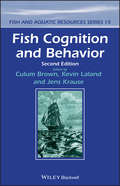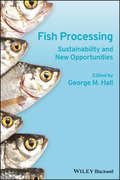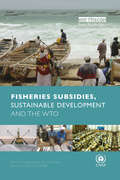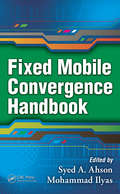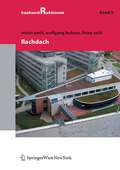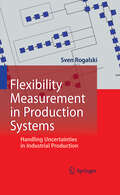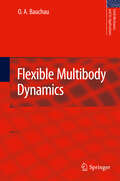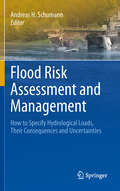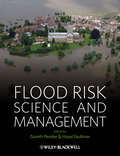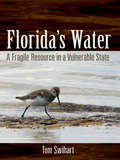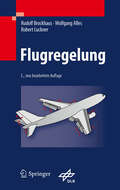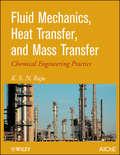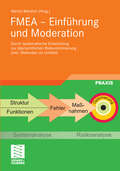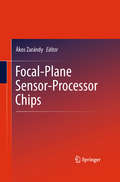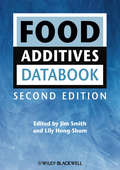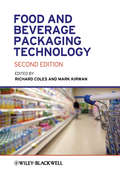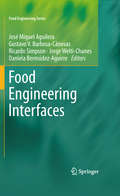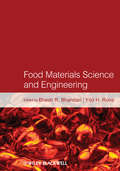- Table View
- List View
Fish Cognition and Behavior (Fish and Aquatic Resources #20)
by Culum Brown Kevin Laland Jens KrauseIn the second edition of this fascinating book an international team of experts have been brought together to explore all major areas of fish learning, including: Foraging skills Predator recognition Social organisation and learning Welfare and pain Three new chapters covering fish personality, lateralisation, and fish cognition and fish welfare, have been added to this fully revised and expanded second edition. Fish Cognition and Behavior, Second Edition contains essential information for all fish biologists and animal behaviorists and contains much new information of commercial importance for fisheries managers and aquaculture personnel. Libraries in all universities and research establishments where biological sciences, fisheries and aquaculture are studied and taught will find it an important addition to their shelves.
Fish Processing: Sustainability and New Opportunities
by George M. HallThis book seeks to address the challenges facing the international seafood industry via a two pronged approach: by offering the latest information on established technologies and introducing new ideas and technologies. An introductory chapter sets the tone for the book by presenting the background against which fish processing will exist in the near future. Chapter two looks at the environmental and sustainability issues relating to conventional fish processing, including processing efficiency and better use of the outputs currently considered wastes. The impact of mechanisation and computerisation on environmental sustainability is also addressed. Subsequent chapters examine the latest developments in established fish processing technologies such as canning, curing, freezing and chilling, with an emphasis on the environmental aspects of packaging and the process itself. In addition, quality and processing parameters for specific species, including new species, are described. The second part of the book gives authors the opportunity to introduce the potential technologies and applications of the future to a wider audience. These include fermented products and their acceptance by a wider audience; the utilisation of fish processing by-products as aquaculture feeds; and the use of by-products for bioactive compounds in biomedical, nutraceutical, cosmetic and other applications.
Fisheries Subsidies, Sustainable Development and the WTO
by Anja Von MoltkeThe fisheries sector is in crisis. Inappropriate subsidies to the fishing industry are a key factor responsible for worldwide fisheries depletion, overcapitalization and ecosystem degradation. There is an urgent need for an international mechanism to promote the appropriate restructuring of fisheries subsidies in order to create a more sustainable industry. In recent years the leading international forum charged with providing such a mechanism has been the World Trade Organization (WTO). This book explains why and how the reform of fisheries subsidies has become one of the most concrete and potentially successful international efforts to achieve global environmental, economic and developmental policy coherence. It describes the history and current status of the discussions at the WTO, drawing on UNEP's key documents and reflecting on the major issues. Accompanying the book is a CD-Rom containing full-text versions of the most important source material used in the publication. The book is aimed at a broad stakeholder audience, including policymakers in the fields of trade, fisheries, environmental economics and international environmental governance, as well as academics and others looking for an overview of the fisheries subsidies issue and an introduction to its technical components. Published with the United Nations Environment Programme (UNEP)
Fisheries Subsidies, Sustainable Development and the WTO
by Anja Von MoltkeThe fisheries sector is in crisis. Inappropriate subsidies to the fishing industry are a key factor responsible for worldwide fisheries depletion, overcapitalization and ecosystem degradation. There is an urgent need for an international mechanism to promote the appropriate restructuring of fisheries subsidies in order to create a more sustainable industry. In recent years the leading international forum charged with providing such a mechanism has been the World Trade Organization (WTO). This book explains why and how the reform of fisheries subsidies has become one of the most concrete and potentially successful international efforts to achieve global environmental, economic and developmental policy coherence. It describes the history and current status of the discussions at the WTO, drawing on UNEP's key documents and reflecting on the major issues. Accompanying the book is a CD-Rom containing full-text versions of the most important source material used in the publication. The book is aimed at a broad stakeholder audience, including policymakers in the fields of trade, fisheries, environmental economics and international environmental governance, as well as academics and others looking for an overview of the fisheries subsidies issue and an introduction to its technical components. Published with the United Nations Environment Programme (UNEP)
Fixed Mobile Convergence Handbook
by Syed A. Ahson Mohammad IlyasRequirements for next generation networks (NGNs) are fueling an architectural evolution. Service providers are obliged to give users access to content anytime, anyhow, anywhere, on any device. This requires a converged infrastructure in which users across multiple domains can be served through a single unified domain and all network services and business units can be consolidated on a single IP infrastructure. The Fixed Mobile Convergence Handbook is a comprehensive guide to the design, implementation, and management of converged cellular/WiFi wireless networks. This book discusses how FMC is transforming technologies as multimedia ceases to be passively consumed and unidirectional—and becomes increasingly mobile, personalized and interactive. This book also describes ways to ensure that networks remain cost-effective, scalable, reliable, and secure in the face of constant technological evolution. This material encapsulates the state of FMC, covering everything from basic concepts to research-grade material and future directions. Addressing a broad range of topics, the handbook consists of 16 chapters authored by 44 experts from around the world. Subjects include: Femtocell network technology and applications Deployment modes and interference avoidance Architecture for power efficiency Conversational quality and network planning Design of SIP-based mobility management protocols Highly respected in their field, the authors anticipate the key issues and problems that FMC presents—from application inception and deployment to system interconnection and Quality of Service (QoS). Ideal for professional mobile technology designers and/or planners, researchers (faculty members and graduate students), this book provides specific salient features and information that will guide innovation in the 21st century and beyond. Syed Ahson is a senior software design engineer with Microsoft. Previously, he was a senior staff software engineer with Motorola, where he was a leading contributor in the creation of several iDEN, CDMA, and GSM cellular phones. Dr. Mohammad Ilyas is associate dean for research and industry relations at the College of Engineering and Computer Science at Florida Atlantic University, Boca Raton. A consultant to several national and international organizations, Dr. Ilyas is a member of both the IEEE and ASEE.
Fixed Mobile Convergence Handbook
by Syed A. Ahson and Mohammad IlyasRequirements for next generation networks (NGNs) are fueling an architectural evolution. Service providers are obliged to give users access to content anytime, anyhow, anywhere, on any device. This requires a converged infrastructure in which users across multiple domains can be served through a single unified domain and all network services and business units can be consolidated on a single IP infrastructure. The Fixed Mobile Convergence Handbook is a comprehensive guide to the design, implementation, and management of converged cellular/WiFi wireless networks. This book discusses how FMC is transforming technologies as multimedia ceases to be passively consumed and unidirectional—and becomes increasingly mobile, personalized and interactive. This book also describes ways to ensure that networks remain cost-effective, scalable, reliable, and secure in the face of constant technological evolution. This material encapsulates the state of FMC, covering everything from basic concepts to research-grade material and future directions. Addressing a broad range of topics, the handbook consists of 16 chapters authored by 44 experts from around the world. Subjects include: Femtocell network technology and applications Deployment modes and interference avoidance Architecture for power efficiency Conversational quality and network planning Design of SIP-based mobility management protocols Highly respected in their field, the authors anticipate the key issues and problems that FMC presents—from application inception and deployment to system interconnection and Quality of Service (QoS). Ideal for professional mobile technology designers and/or planners, researchers (faculty members and graduate students), this book provides specific salient features and information that will guide innovation in the 21st century and beyond. Syed Ahson is a senior software design engineer with Microsoft. Previously, he was a senior staff software engineer with Motorola, where he was a leading contributor in the creation of several iDEN, CDMA, and GSM cellular phones. Dr. Mohammad Ilyas is associate dean for research and industry relations at the College of Engineering and Computer Science at Florida Atlantic University, Boca Raton. A consultant to several national and international organizations, Dr. Ilyas is a member of both the IEEE and ASEE.
Flachdach (Baukonstruktionen #9)
by Anton Pech Wolfgang Hubner Franz ZachDas Flachdach als großflächiger Bauteil ist den höchsten Belastungen amGesamtbauwerk ausgesetzt. Speziell im Hinblick auf die künftigen Auswirkungen des Klimawandels muss die Planung und Ausführung von Flachdächern schon heute abgestimmt werden. Der vorliegende Band gibt daher – ausgehend von der Behandlung der Grundkonstruktionen – eine ausführliche und fundierte Darstellung dieses Fachgebietes, wobei den immer aktueller werdenden begrünten Dächern ein eigener Abschnitt gewidmet ist. Besonderes Augenmerk ist bei Flachdächern auchder Ausbildung von Durchdringungen und Anschlüssen zu widmen.
Flexibility Measurement in Production Systems: Handling Uncertainties in Industrial Production
by Sven RogalskiThe requirements for production systems are constantly changing as a result of changing competitive conditions. This poses a challenge for manufacturers in the various branches of industry and creates an ever-increasing need for flexibility.With this as a background, this book explores the current developments and trends as well as their impact on today’s production systems. It also compares known strategies, concepts and methods used to achieve production flexibility. Similarly, the practical knowledge and current research will be drawn upon and subjected to a sound scientific analysis, through which the technical and organizational flexibility ranges can be measured in their application in a production system. The convenience and usefulness of this concept for manufacturers is substantiated by its implementation in a software tool called ecoFLEX and its practical application, based on extensive examples. This illustrates how flexibility flaws can be quickly identified, classified and properly disposed of using ecoFLEX. This tool helps to close the gap between ERP / PPS systems and digital factory planning tools.
Flexible Multibody Dynamics (Solid Mechanics and Its Applications #176)
by O. A. BauchauThe author developed this text over many years, teaching graduate courses in advanced dynamics and flexible multibody dynamics at the Daniel Guggenheim School of Aerospace Engineering of the Georgia Institute of Technology. The book presents a unified treatment of rigid body dynamics, analytical dynamics, constrained dynamics, and flexible multibody dynamics. A comprehensive review of numerical tools used to enforce both holonomic and nonholonomic constraints is presented. Advanced topics such as Maggi’s, index-1, null space, and Udwadia and Kalaba’s formulations are presented because of their fundamental importance in multibody dynamics. Methodologies for the parameterization of rotation and motion are discussed and contrasted. Geometrically exact beams and shells formulations, which have become the standard in flexible multibody dynamics, are presented and numerical aspects of their finite element implementation detailed. Methodologies for the direct solution of the index-3 differential-algebraic equations characteristic of constrained multibody systems are presented. It is shown that with the help of proper scaling procedures, such equations are not more difficult to integrate than ordinary differential equations. This book is illustrated with numerous examples and should prove valuable to both students and researchers in the fields of rigid and flexible multibody dynamics.
Flood Risk Assessment and Management: How to Specify Hydrological Loads, Their Consequences and Uncertainties
by Andreas H. SchumannFlood catastrophes which happened world-wide have shown that it is not sufficient to characterize the hazard caused by the natural phenomenon "flood" with the well-known 3M-approach (measuring, mapping and modelling). Due to the recent shift in paradigms from a safety oriented approach to risk based planning it became necessary to consider the harmful impacts of hazards. The planning tasks changed from attempts to minimise hazards towards interventions to reduce exposure or susceptibility and nowadays to enhance the capacities to increase resilience. Scientific interest shifts more and more towards interdisciplinary approaches, which are needed to avoid disaster. This book deals with many aspects of flood risk management in a comprehensive way. As risks depend on hazard and vulnerabilities, not only geophysical tools for flood forecasting and planning are presented, but also socio-economic problems of flood management are discussed. Starting with precipitation and meteorological tools to its forecasting, hydrological models are described in their applications for operational flood forecasts, considering model uncertainties and their interactions with hydraulic and groundwater models. With regard to flood risk planning, regionalization aspects and the options to utilize historic floods are discussed. New hydrological tools for flood risk assessments for dams and reservoirs are presented. Problems and options to quantify socio-economic risks and how to consider them in multi-criteria assessments of flood risk planning are discussed. This book contributes to the contemporary efforts to reduce flood risk at the European scale. Using many real-world examples, it is useful for scientists and practitioners at different levels and with different interests.
Flood Risk Science and Management
by Gareth Pender Hazel FaulknerApproaches to avoid loss of life and limit disruption and damage from flooding have changed significantly in recent years. Worldwide, there has been a move from a strategy of flood defence to one of flood risk management. Flood risk management includes flood prevention using hard defences, where appropriate, but also requires that society learns to live with floods and that stakeholders living in flood prone areas develop coping strategies to increase their resilience to flood impacts when these occur. This change in approach represents a paradigm shift which stems from the realisation that continuing to strengthen and extend conventional flood defences is unsustainable economically, environmentally, and in terms of social equity. Flood risk management recognises that a sustainable approach must rest on integrated measures that reduce not only the probability of flooding, but also the consequences. This is essential as increases in the probability of inundation are inevitable in many areas of the world due to climate change, while socio-economic development will lead to spiralling increases in the consequences of flooding unless land use in floodplains is carefully planned. Flood Risk Science and Management provides an extensive and comprehensive synthesis of current research in flood management; providing a multi-disciplinary reference text covering a wide range of flood management topics. Its targeted readership is the international research community (from research students through to senior staff) and flood management professionals, such as engineers, planners, government officials and those with flood management responsibility in the public sector. By using the concept of case study chapters, international coverage is given to the topic, ensuring a world-wide relevance.
Flood Risk Science and Management
by Gareth Pender Hazel FaulknerApproaches to avoid loss of life and limit disruption and damage from flooding have changed significantly in recent years. Worldwide, there has been a move from a strategy of flood defence to one of flood risk management. Flood risk management includes flood prevention using hard defences, where appropriate, but also requires that society learns to live with floods and that stakeholders living in flood prone areas develop coping strategies to increase their resilience to flood impacts when these occur. This change in approach represents a paradigm shift which stems from the realisation that continuing to strengthen and extend conventional flood defences is unsustainable economically, environmentally, and in terms of social equity. Flood risk management recognises that a sustainable approach must rest on integrated measures that reduce not only the probability of flooding, but also the consequences. This is essential as increases in the probability of inundation are inevitable in many areas of the world due to climate change, while socio-economic development will lead to spiralling increases in the consequences of flooding unless land use in floodplains is carefully planned. Flood Risk Science and Management provides an extensive and comprehensive synthesis of current research in flood management; providing a multi-disciplinary reference text covering a wide range of flood management topics. Its targeted readership is the international research community (from research students through to senior staff) and flood management professionals, such as engineers, planners, government officials and those with flood management responsibility in the public sector. By using the concept of case study chapters, international coverage is given to the topic, ensuring a world-wide relevance.
Florida's Water: A Fragile Resource in a Vulnerable State
by Tom SwihartFlorida's Water poses fundamental questions about water sustainability in the United States' fourth largest state. Florida has long-standing water quality problems. Global climate change threatens to intensify Florida's floods and droughts, make hurricanes more common or more damaging, and eventually submerge much of low-lying Florida, including the Everglades. How can Florida meet these extraordinary challenges? And what lessons does the Florida experience hold for other states? This book fully integrates the many diverse responsibilities of water management into a readable and compelling combination of interesting narratives and deep analysis. Author Tom Swihart's unique, intimate knowledge of Florida's successes and failures in water management brings out both the novelty of Florida's water situation and the features that it has in common with other states.
Florida's Water: A Fragile Resource in a Vulnerable State
by Tom SwihartFlorida's Water poses fundamental questions about water sustainability in the United States' fourth largest state. Florida has long-standing water quality problems. Global climate change threatens to intensify Florida's floods and droughts, make hurricanes more common or more damaging, and eventually submerge much of low-lying Florida, including the Everglades. How can Florida meet these extraordinary challenges? And what lessons does the Florida experience hold for other states? This book fully integrates the many diverse responsibilities of water management into a readable and compelling combination of interesting narratives and deep analysis. Author Tom Swihart's unique, intimate knowledge of Florida's successes and failures in water management brings out both the novelty of Florida's water situation and the features that it has in common with other states.
Flugregelung
by Rudolf Brockhaus Wolfgang Alles Robert LucknerDas Buch liefert die Grundlagen für den Vorentwurf von Flugregelungssystemen. Der systematische Aufbau führt Leser von einfachen Strukturen für Dämpfer, Autostabilisatoren und Lageregler hin zu komplexen Gesamtsystemen (Automatic Flight Control System).
Fluid Mechanics, Heat Transfer, and Mass Transfer: Chemical Engineering Practice
by K. S. RajuThis broad-based book covers the three major areas of Chemical Engineering. Most of the books in the market involve one of the individual areas, namely, Fluid Mechanics, Heat Transfer or Mass Transfer, rather than all the three. This book presents this material in a single source. This avoids the user having to refer to a number of books to obtain information. Most published books covering all the three areas in a single source emphasize theory rather than practical issues. This book is written with emphasis on practice with brief theoretical concepts in the form of questions and answers, not adopting stereo-typed question-answer approach practiced in certain books in the market, bridging the two areas of theory and practice with respect to the core areas of chemical engineering. Most parts of the book are easily understandable by those who are not experts in the field. Fluid Mechanics chapters include basics on non-Newtonian systems which, for instance find importance in polymer and food processing, flow through piping, flow measurement, pumps, mixing technology and fluidization and two phase flow. For example it covers types of pumps and valves, membranes and areas of their use, different equipment commonly used in chemical industry and their merits and drawbacks. Heat Transfer chapters cover the basics involved in conduction, convection and radiation, with emphasis on insulation, heat exchangers, evaporators, condensers, reboilers and fired heaters. Design methods, performance, operational issues and maintenance problems are highlighted. Topics such as heat pipes, heat pumps, heat tracing, steam traps, refrigeration, cooling of electronic devices, NOx control find place in the book. Mass transfer chapters cover basics such as diffusion, theories, analogies, mass transfer coefficients and mass transfer with chemical reaction, equipment such as tray and packed columns, column internals including structural packings, design, operational and installation issues, drums and separators are discussed in good detail. Absorption, distillation, extraction and leaching with applications and design methods, including emerging practices involving Divided Wall and Petluk column arrangements, multicomponent separations, supercritical solvent extraction find place in the book.
Fluid Mechanics, Heat Transfer, and Mass Transfer: Chemical Engineering Practice
by K. S. RajuThis broad-based book covers the three major areas of Chemical Engineering. Most of the books in the market involve one of the individual areas, namely, Fluid Mechanics, Heat Transfer or Mass Transfer, rather than all the three. This book presents this material in a single source. This avoids the user having to refer to a number of books to obtain information. Most published books covering all the three areas in a single source emphasize theory rather than practical issues. This book is written with emphasis on practice with brief theoretical concepts in the form of questions and answers, not adopting stereo-typed question-answer approach practiced in certain books in the market, bridging the two areas of theory and practice with respect to the core areas of chemical engineering. Most parts of the book are easily understandable by those who are not experts in the field. Fluid Mechanics chapters include basics on non-Newtonian systems which, for instance find importance in polymer and food processing, flow through piping, flow measurement, pumps, mixing technology and fluidization and two phase flow. For example it covers types of pumps and valves, membranes and areas of their use, different equipment commonly used in chemical industry and their merits and drawbacks. Heat Transfer chapters cover the basics involved in conduction, convection and radiation, with emphasis on insulation, heat exchangers, evaporators, condensers, reboilers and fired heaters. Design methods, performance, operational issues and maintenance problems are highlighted. Topics such as heat pipes, heat pumps, heat tracing, steam traps, refrigeration, cooling of electronic devices, NOx control find place in the book. Mass transfer chapters cover basics such as diffusion, theories, analogies, mass transfer coefficients and mass transfer with chemical reaction, equipment such as tray and packed columns, column internals including structural packings, design, operational and installation issues, drums and separators are discussed in good detail. Absorption, distillation, extraction and leaching with applications and design methods, including emerging practices involving Divided Wall and Petluk column arrangements, multicomponent separations, supercritical solvent extraction find place in the book.
FMEA - Einführung und Moderation: Durch systematische Entwicklung zur übersichtlichen Risikominimierung (inkl. Methoden im Umfeld)
by Martin WerdichDieses Buch hilft Ihnen, die Methodik FMEA sowie die angrenzenden Themen zu verstehen und anzuwenden. Es räumt mit dem Vorurteil auf, FMEA wäre „nur“ ein Qualitätstool, das von Qualitätsspezialisten durchgeführt wird. Vielmehr kann die FMEA in jeder Branche als Werkzeug benutzt werden, um Produkte, Projekte, Aufgaben und Dienstleistungen äußerst planbar, nachvollziehbar und zielorientiert umzusetzen. Das strukturierte Vorgehen unterstützt Problemlösungen und schafft somit neue Denkansätze (präventive Qualitätssicherungsmethodik und Risikoanalyse). Bei richtiger Anwendung werden Sie Zeit, Geld und Kapazität einsparen.
Focal-Plane Sensor-Processor Chips
by Ákos ZarándyFocal-plane sensor-processor imager devices are sensor arrays and processor arrays embedded in each other on the same silicon chip. This close coupling enables ultra-fast processing even on tiny, low power devices, because the slow and energetically expensive transfer of the large amount of sensory data is eliminated. This technology also makes it possible to produce locally adaptive sensor arrays, which can (similarly to the human retina) adapt to the large dynamics of the illumination in a single scene This book focuses on the implementation and application of state-of-the-art vision chips. It provides an overview of focal plane chip technology, smart imagers and cellular wave computers, along with numerous examples of current vision chips, 3D sensor-processor arrays and their applications. Coverage includes not only the technology behind the devices, but also their near- and mid-term research trends.
Food Additives Data Book
by Jim Smith Lily Hong-ShumThe use of additives in food is a dynamic one, as consumers demand fewer additives in foods and as governments review the list of additives approved and their permitted levels. Scientists also refine the knowledge of the risk assessment process as well as improve analytical methods and the use of alternative additives, processes or ingredients. Since the first edition of the Food Additives Databook was published, there have been numerous changes due to these developments and some additives are no longer permitted, some have new permitted levels of use and new additives have been assessed and approved. The revised second edition of this major reference work covers all the "must-have" technical data on food additives. Compiled by food industry experts with a proven track record of producing high quality reference work, this volume is the definitive resource for technologists in small, medium and large companies, and for workers in research, government and academic institutions. Coverage is of Preservatives, Enzymes, Gases, Nutritive additives, Emulsifiers, Flour additives, Acidulants, Sequestrants, Antioxidants, Flavour enhancers, Colour, Sweeteners, Polysaccharides, Solvents. Entries include information on: Function and Applications, Safety issues, International legal issues, Alternatives, Synonyms, Molecular Formula and mass, Alternative forms, Appearance, Boiling, melting, and flash points, density, purity, water content, solubility, Synergists, Antagonists, and more with full and easy-to-follow-up references. Reviews of the first edition: "Additives have their advantages for the food industry in order to provide safe and convenient food products. It is therefore essential that as much information as possible is available to allow an informed decision on the selection of an additive for a particular purpose. This data book provides such information - consisting of over 1000 pages and covering around 350 additives. This data book does provide a vast amount of information; it is what it claims to be! Overall, this is a very useful publication and a good reference book for anyone working in the food and dairy industry." —International Journal of Dairy Technology, Volume 59 Issue 2, May 2006 "This book is the best I have ever seen ... a clear winner over all other food additive books .... a superb edition." —SAAFOST (South African Association for Food Science and Technology)
Food Additives Data Book
by Jim Smith Lily Hong-ShumThe use of additives in food is a dynamic one, as consumers demand fewer additives in foods and as governments review the list of additives approved and their permitted levels. Scientists also refine the knowledge of the risk assessment process as well as improve analytical methods and the use of alternative additives, processes or ingredients. Since the first edition of the Food Additives Databook was published, there have been numerous changes due to these developments and some additives are no longer permitted, some have new permitted levels of use and new additives have been assessed and approved. The revised second edition of this major reference work covers all the "must-have" technical data on food additives. Compiled by food industry experts with a proven track record of producing high quality reference work, this volume is the definitive resource for technologists in small, medium and large companies, and for workers in research, government and academic institutions. Coverage is of Preservatives, Enzymes, Gases, Nutritive additives, Emulsifiers, Flour additives, Acidulants, Sequestrants, Antioxidants, Flavour enhancers, Colour, Sweeteners, Polysaccharides, Solvents. Entries include information on: Function and Applications, Safety issues, International legal issues, Alternatives, Synonyms, Molecular Formula and mass, Alternative forms, Appearance, Boiling, melting, and flash points, density, purity, water content, solubility, Synergists, Antagonists, and more with full and easy-to-follow-up references. Reviews of the first edition: "Additives have their advantages for the food industry in order to provide safe and convenient food products. It is therefore essential that as much information as possible is available to allow an informed decision on the selection of an additive for a particular purpose. This data book provides such information - consisting of over 1000 pages and covering around 350 additives. This data book does provide a vast amount of information; it is what it claims to be! Overall, this is a very useful publication and a good reference book for anyone working in the food and dairy industry." —International Journal of Dairy Technology, Volume 59 Issue 2, May 2006 "This book is the best I have ever seen ... a clear winner over all other food additive books .... a superb edition." —SAAFOST (South African Association for Food Science and Technology)
Food and Beverage Packaging Technology
by Richard Coles Mark J. KirwanNow in a fully revised and updated second edition, this volume provides a contemporary overview of food processing/packaging technologies. It acquaints the reader with food preservation processes, shelf life and logistical considerations, as well as packaging materials, machines and processes necessary for a wide range of packaging presentations. The new edition addresses environmental and sustainability concerns, and also examines applications of emerging technologies such as RFID and nanotechnology. It is directed at packaging technologists, those involved in the design and development of packaging, users of packaging in food companies and those who specify or purchase packaging. Key Features: An up-to-date and comprehensive handbook on the most important sector of packaging technology Links methods of food preservation to the packaging requirements of the common types of food and the available food packages Covers all the key packaging materials - glass, plastics and paperboard Fully revised second edition now covers sustainability, nanotechnology and RFID
Food and Beverage Packaging Technology
by Richard Coles Mark J. KirwanNow in a fully revised and updated second edition, this volume provides a contemporary overview of food processing/packaging technologies. It acquaints the reader with food preservation processes, shelf life and logistical considerations, as well as packaging materials, machines and processes necessary for a wide range of packaging presentations. The new edition addresses environmental and sustainability concerns, and also examines applications of emerging technologies such as RFID and nanotechnology. It is directed at packaging technologists, those involved in the design and development of packaging, users of packaging in food companies and those who specify or purchase packaging. Key Features: An up-to-date and comprehensive handbook on the most important sector of packaging technology Links methods of food preservation to the packaging requirements of the common types of food and the available food packages Covers all the key packaging materials - glass, plastics and paperboard Fully revised second edition now covers sustainability, nanotechnology and RFID
Food Engineering Interfaces (Food Engineering Series)
by José Miguel Aguilera, Ricardo Simpson, Jorge Welti-Chanes, Daniela Bermudez-Aguirre and Gustavo Barbosa-CanovasThe International Conference on Food Engineering is held every four years and draws global participation. ICEF 10 will be held in April 2008 in Chile with the theme of food engineering at interfaces. This will not be a typical proceedings with uneven contributions. Papers will be solicited from each plenary speaker plus two or three invited speakers from each topic and the goal is to publish a book that conveys the interdisciplinary spirit of the meeting as well as covers the topics in depth, creating a strong reference work. The idea is to explore how food engineers have to be prepared in years ahead not only to perform in their normal activities but also to engage in new challenges and opportunities that will make the profession more attractive, responsive, and able to create a larger impact. These challenges and opportunities are within the profession and at interfaces with other areas. A major role of engineers is to incorporate new knowledge into the profession and respond to practical needs. The goal is to explore how food engineers are integrating developments in the basic sciences of physics and chemistry, nutrition, informatics, material sciences, genomics (and other -omics), quality and safety, consumer behavior and gastronomy. Interfaces with the environment, the business sector, regulations and export markets are also important to consider.
Food Materials Science and Engineering
by Bhesh BhandariFood Materials Science and Engineering covers a comprehensive range of topics in relation to food materials, their properties and characterisation techniques, thus offering a new approach to understanding food production and quality control. The opening chapter will define the scope and application of food materials science, explaining the relationship between raw material structure and processing and quality in the final product. Subsequent chapters will examine the structure of food materials and how they relate to quality, sensory perception, processing attributes and nutrient delivery. The authors also address applications of nanotechnology to food and packaging science. Methods of manufacturing food systems with improved shelf-life and quality attributes will be highlighted in the book.
